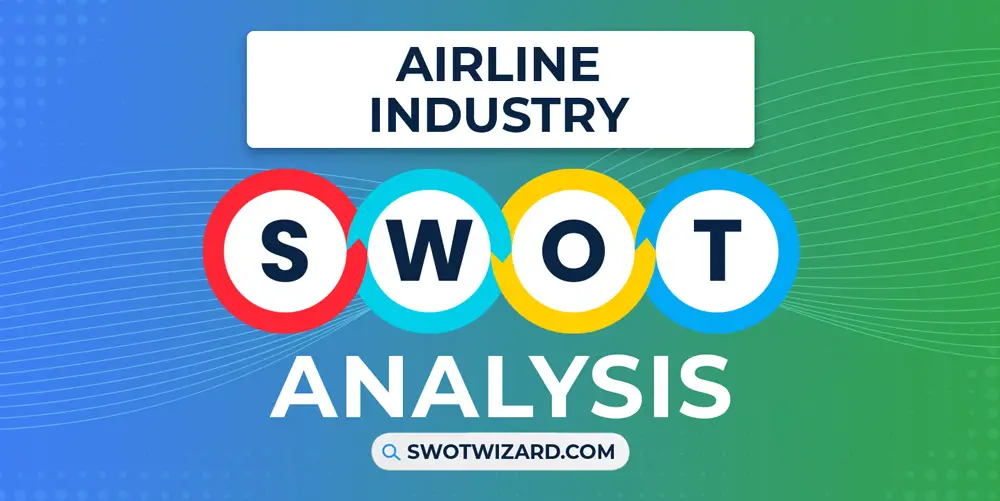The tourism industry is one of the largest industries in terms of market size, not to mention a channel to connect different people, history, and culture. People have been traveling since Adam, and we couldn’t even explore half of the world, which we will get to know more about in this tourism industry SWOT analysis.
Tourism Industry Overview
The Egyptians, Greeks, and Romans engaged in early forms of tourism, traveling for religious pilgrimages, leisure, and educational purposes. The ritual continues with more options, better transportation, accommodation, and different forms.
Over a thousand years of history, the industry has become a $2T industry, with thousands of spots and employing 295M people worldwide.
Competitors in Tourism Industry
booking.com | Airbnb | Expedia | Hilton | Marriott | Royal Caribbean Internation | Norwegian Cruise
Did You Know?
In 1967, a travel agency in Illinois offered reservations for trips to the moon, even though the technology and logistics were far from feasible at that time.
Strengths – Tourism Industry SWOT Analysis
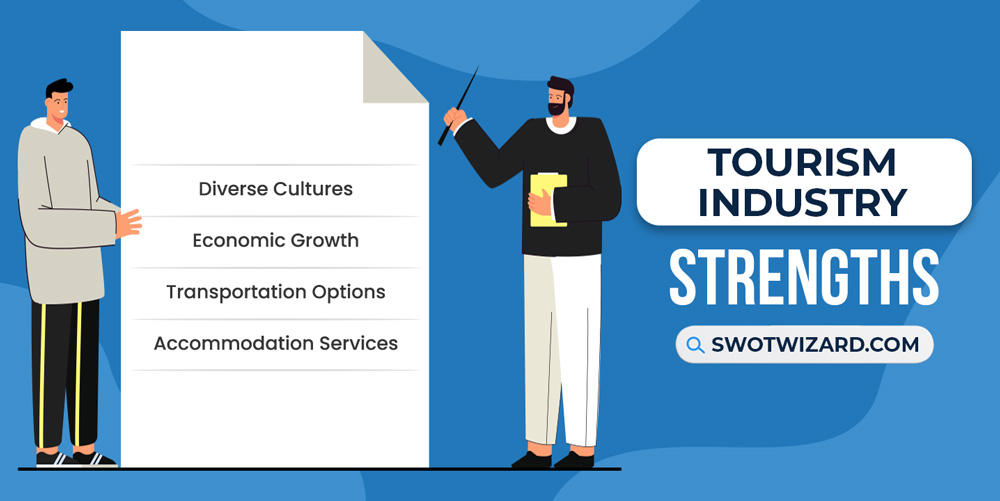
Diverse Cultures: Tourism allows travelers to experience and learn about new cultures, and Experiencing local art, food, and traditions is a major draw. According to the data, cultural tourism accounted for nearly 40% of all global tourism, generating billions in tourism receipts globally, according to UNWTO.
Economic Growth: Tourism stimulates infrastructure investment and creates transportation, hospitality, and retail jobs. As a result, the tourism industry alone contributed 7.6% of global GDP and created 295M jobs globally in 2022, according to WTTC. In Hawaii, the industry contributes almost the GDP, and many countries like this depend entirely on the single sector and employ most of the people.
Transportation Options: Modern transportation networks provide easy access to global destinations, and because of that, Global air connectivity has increased by over 67% in the last decade, enabling convenient tourism growth. Options like budget airlines and cruises allow travelers access at competitive rates, and the efficiency of Tokyo’s extensive public transportation system is the perfect example.
Accommodation Services: The hospitality industry’s evolution accommodates diverse traveler preferences like homestays, hostels, resorts, etc. There were approximately 18M hotel rooms globally, with annual occupancy rates exceeding 70.1% in many regions. Besides, Airbnb offers unique stays, boosting local economies while providing personalized experiences that resonate with today’s travelers.
Weaknesses – Tourism Industry SWOT Analysis
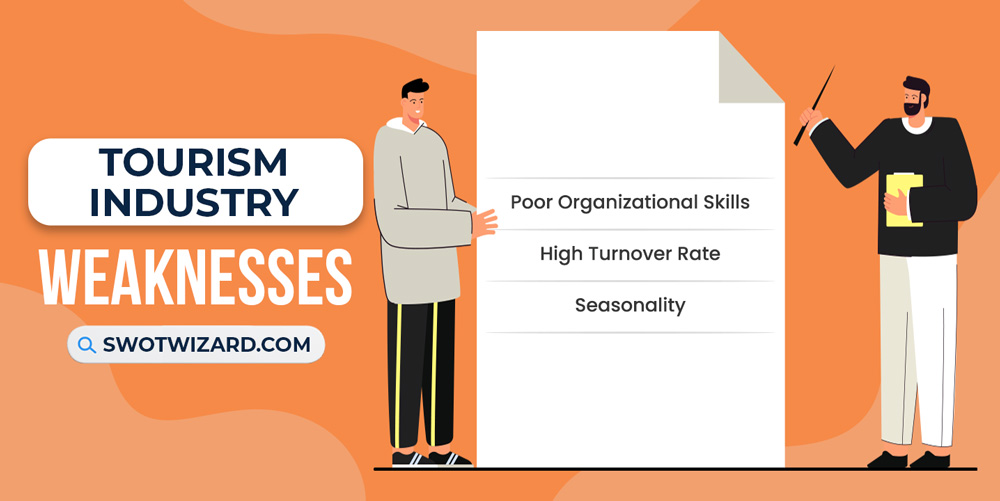
Poor Organizational Skills: Inefficiencies in coordination can hinder the seamless operation of tourist facilities, and as an industry, the businesses often lack strategic planning and vision. According to the data, less than 14% of tour companies in Africa had business plans, leading to haphazard decision-making.
High Turnover Rate: The industry often grapples with high employee turnover due to demanding work conditions and the seasonal nature of the business. The turnover rates reached 34.6% for leisure and hospitality employees in the USA alone in 2022, impacting service consistency.
Seasonality: Tourism demand fluctuates significantly between peak and off-peak seasons, requiring flexibility in staffing and operations. If we look at the data, the hotel occupancy rates in Miami ranged from 83% in March to 62.8% in September, a 25% swing between high and low season in the last year.
Opportunities – Tourism Industry SWOT Analysis
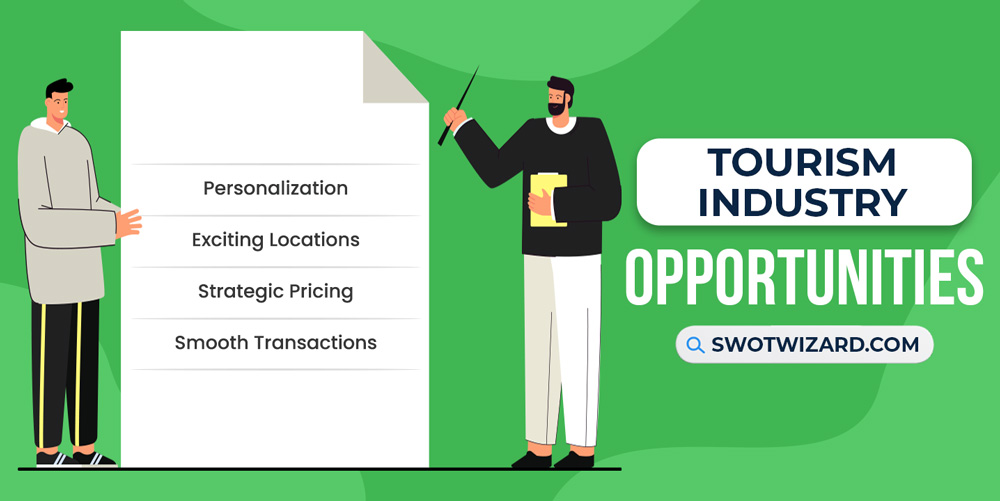
Personalization: Tailoring experiences to individual preferences fosters a deeper connection, and travelers increasingly want customized, authentic experiences. The global personalized travel market is projected to grow at a CAGR of around 4.42% from 2023-2027. Besides, Airbnb’s personalized recommendations based on traveler history have led to a massive increase in guest bookings.
Exciting Locations: Seeking new destinations, like up-and-coming cities or exotic natural sites, drives tourism. Adventure travel spending reached $1036B in 2022, growing by 19.6% in the past six years, and the success of Iceland’s tourism showcases how breathtaking landscapes can draw visitors seeking unforgettable adventures.
Strategic Pricing: Dynamic pricing driven by demand data allows tourism businesses to maximize revenues. Airlines change fares 500M times daily based on date, destination, and competition, leading to a 5-10% increase in revenue across the industry. Similarly, Disney’s tiered ticket pricing increased revenue by 25% at peak times while promoting off-peak visits.
Smooth Transactions: Tourism tech startups are easing travel planning, like online booking sites aggregating flight/hotel deals. Global travel sales through mobile are projected to account for $1T, over 90% of online bookings in 2030, up from 50% in 2022, $798B, demonstrating the impact of user-friendly transactions.
Threats – Tourism Industry SWOT Analysis
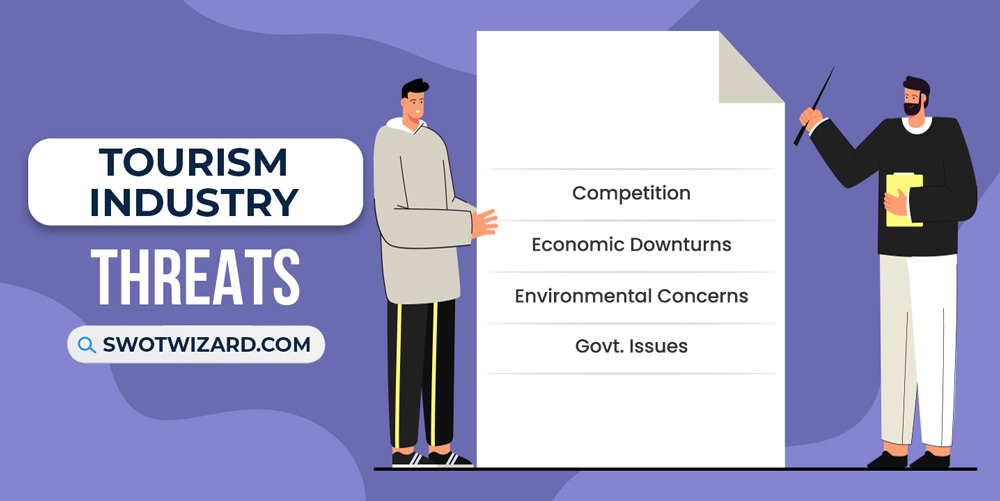
Competition: Intense rivalry among destinations amplifies the pressure to differentiate. European cities like Paris and Rome compete for cultural tourism, investing in museums and historical sites to entice travelers, intensifying the struggle for the tourism market share. If we look at the data, Southeast Asia saw tourism grow significantly in the last few years, while arrivals fell in Europe during the same period.
Economic Downturns: Economic instability curtails disposable income, impacting travel decisions. The 2008 financial crisis saw a global decline in tourism growth, with international tourist arrivals dropping by 4.2%, highlighting the industry’s vulnerability to economic downturns. As a result, it’s concerning as there is a 2024 recession coming the way, and it might hit the industry significantly.
Environmental Concerns: Heightened awareness of sustainability sparks traveler scrutiny, and Tourism contributes to 5% of global CO2 emissions from transport, infrastructure, and activities, and it might increase to 5.3% in the next few years. The Great Barrier Reef’s coral bleaching drew attention to ecotourism’s dilemma, as visitors became more conscious of their environmental impact, reducing tourist interest and revenues.
Govt. Issues: Evolving regulations can disrupt travel plans, and changes to visa policies, travel advisories, regulations, etc., have become a huge issue nowadays. Brexit created uncertainty for travelers between the UK and the EU, with changing visa requirements and border processes altering travel dynamics and potentially discouraging visits. Not to mention, after the USA imposed travel restrictions a few years ago, its share of the long-haul travel market fell.
[Bonus Infographic] SWOT Analysis of Tourism Industry
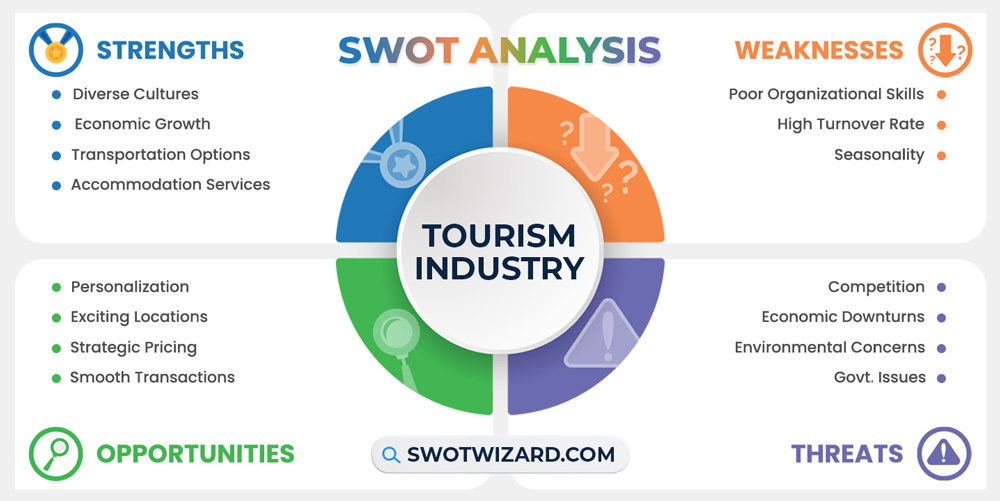
Recommendations for Tourism Industry
Keeping up with the change and growing overall is crucial in the ever-changing tourism industry. Here are some recommendations for the stakeholders in the industry.
- Tailor marketing efforts to individual preferences and behaviors, like targeting families with deals on kid-friendly activities and restaurants.
- Highlight destinations’ unique experiences through immersive storytelling and promote off-the-beaten-path destinations to establish location brands with new exciting locations.
- Implement dynamic pricing models to accommodate diverse customer segments and demand fluctuations.
- Invest in seamless online booking and payment systems, self-service kiosks, and mobile apps to facilitate frictionless trip planning and on-site transactions.
- Partner with providers of unique accommodations like homestays, cabins, and boutique hotels to offer personalized and authentic stays.
Frequently Asked Questions (FAQs)
What are the 4 A’s of tourism?
The 4 A's of tourism are attraction, accessibility, amenity, and ancillary services.
How big is the tourism industry?
The tourism industry is $2T big.
Final Words on Tourism Industry SWOT Analysis
The tourism industry is dynamic in an ever-evolving landscape, offering boundless opportunities and navigating intricate challenges. Balancing innovation with sustainability and personalized experiences with mass appeal remains a cornerstone of global economies. With strategic adaptation and collaborative efforts, the industry can continue to unlock the world’s wonders while fostering economic growth and cultural exchange.
References
- Kelleher, S. R. (2023, August 9). Go Time: Airfares Are Dipping, But Low Prices Won’t Last Long. Forbes.
- Walker, T. (2023, July 5). Vietnam emerging as Southeast Asia’s new tourist hot spot. dw.com.



